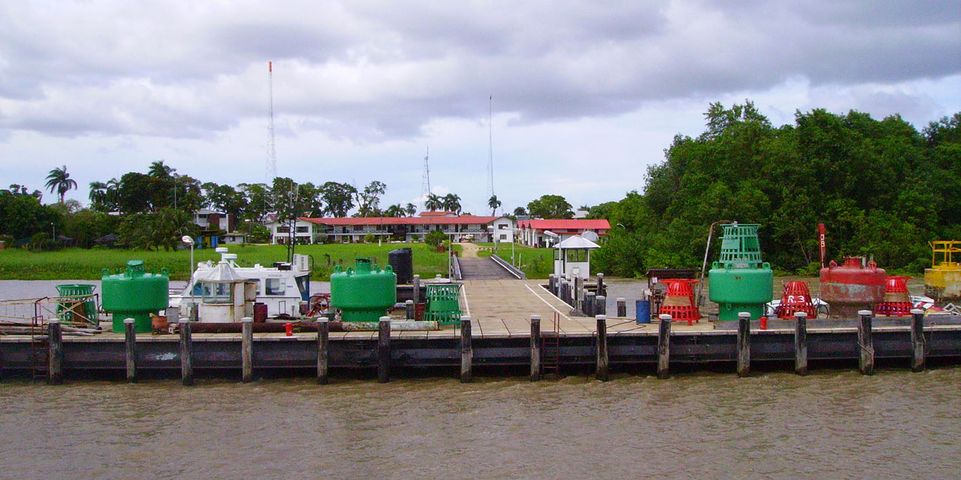HISTORY


Introduction
On July 1, 2007 we commemorated 60 years of maritime development. Looking back on more than half a century, we may conclude that there were more storms and turbulent waters than calm weather and clear blue skies. But it may just be because of those storms that the MAS could achieve many goals and see to it that, at present, Suriname carries weight in the international world of shipping.
Shipping traffic on the rivers has always been a familiar phenomenon in Suriname. First the indigenous people in their primitive dugouts, later the European conquerors, the colonizers, the slave traders and merchant vessels that sailed the waters of Suriname with their barges, yachts, frigates, hookers, snows, slave ships or ships sailing to the West Indies, to name just a few vessels from those times.
Shipping has always been the key to economic development. Ships brought clothing, goods for consumption but also slaves into the country and coffee, cotton, sugar and cocoa were taken out of the country. Up till World War II, Suriname was still entirely dependent on shipping. Bauxite, logging, and agricultural products: it was all exported which meant income for Suriname.
Change of course
In 1947, the Government decided to regulate the shipping sector. Many shipping services, such as the pilot service, were under private management. The Port and Pilot Service was established and all sorts of things were described in laws and rules: who the pilots were, from what point piloting should take place, what vessels there were and where the roadsteads and landing stages of Suriname were located. The Surinamese Government was aware that the shipping sector had to be managed in a different manner than before. Leaving it all in private hands such as before was no longer an option. Still, there remained room for other stakeholders than the Surinamese Government. The Port and Pilot Service was, after all, intended to regulate all water transport but actual sailing and usage of ships and ferries had to be carried out by others, for example the Shipping Company Suriname, a fairly prosperous company in those days that owned a number of ships with which it maintained national and international connections. Suralco had three ore carriers of its own and transported bauxite to, among others, the Unites States.
For centuries, traveling by ship was the only way to go abroad. The Royal Netherlands Steamship Company owned various passenger ships that maintained the connection with the Netherlands. There was also a great task for the Suriname Dry Dock and Shipbuilding Company that built ships and, at a later time, shrimp trawlers for the Suriname Shipping Company.
Heyday
In the sixties, the shipping industry was doing well, also because of the construction of the Afobaka reservoir as a result of which many materials, such as cement from Venezuela, had to be transported over water. The shipping industry also benefited from the great demand for alumina. In the sixties, the Surinamese shipping industry received a great deal of assistance from the Dutch Navy. The Navy printed the nautical charts of Suriname. Temporary employees assisted in drafting these charts, gave training courses and provided technical support. The Hydrography course in particular benefited a great deal from this expertise. Some data was recorded by hand on notepads. Position, time and depth were important to draft accurate charts with hydrographical data. The tide was also recorded by employees of the Hydrographical Service that had to read the water level every five minutes. This could go on for days.
The ports were in a poor state in the sixties. They proved unsatisfactory. The wharf at the Water Front was still important but could barely handle all the traffic anymore. The shipping industry made greater and different demands on port facilities. In 1964, the construction of a new port was initiated with funds from the European Development Fund. Finally, in 1971, the Port Authority was established that was charged with the responsibility for the “New Port”. This port was a substantial improvement compared to the old port of the Royal Netherlands Steamship Company. With the General Wharf at the Water Front, it was 372 meters long while the New Port was 520 meters long. In those days, this was a giant step forward.
The seventies saw some changes in the shipping industry. One of those changes was the increase in container transport. Up till 1977, mostly general cargo was stored at the port, in the sheds and, sometimes, in open air. From 1978, the container transport increased quickly. More and more, ships full of large containers with goods called in at the port. In this manner, cargo was transported throughout the entire world. When this expanded the New Port proved unsatisfactory. After 1971, the Port Authority could no longer make any big investments. That is why, in the eighties and nineties, the New Port did not look so ‘new’ anymore …
Drain of personnel
In 1979, the young Republic of Suriname celebrated its fourth year of independence. The country was on the eve of a military coup that would change a great many things, not only in the political arena but also socially and economically.
One of the problems which the Port and Pilot Service was faced with was the fact that expenditure increased considerably due to the increasing price of fuel, the repair of six vessels and increased personnel costs. Conversely, increases of the various rates imposed by the Service fell behind. In that year, personnel also went on strike for better pay, which was disastrous for the Service. The company came to a standstill, which did not benefit the shipping industry. In addition, more and more qualified personnel left and it became more difficult to hire other personnel because of the non-competitive wages.
The situation in Suriname changed even more after February 25, 1980 when a group of soldiers seized power by means of a coup. After the military coup, the shipping sector, like the rest of the country, found itself in turbulent waters. The then government wanted to merge the port, the pilot service and technical services. But everybody continued doing things their own way and the various services remained separate. The Port and Pilot Service did change its name in 1982 to the Shipping Service. Eddie Fitz-Jim became the new manager. He replaced Lionel Silos who retired.
The Shipping Service introduced rate increases in 1982. This was necessary since some rates had not been adjusted since 1947. This enabled the Service to operate on a reasonable level for some years despite the growing crisis in the country. Still, the drain of qualified personnel could not be prevented. And, in the end, the Shipping Service disappeared in the swirling waters.
Hunting movement
In the period of the Shipping Service, the bauxite industry played an important role because the Surinamese economy remained strongly dependent on this sector. The decline of this sector, also due to the big strike at the end of 1983, and the drop of the bauxite price on the world market, clearly had their impact on the shipping industry. Suriname was in deep trouble.
The war in the interior did not make things any better. Due to the war, the bauxite reserves in the Marowijne District could not be reached for some time. Suralco had to import bauxite to keep the factories operational.
The Shipping Service declined further in the second half of the eighties and even more in the first half of the nineties. The equipment became antiquated and could barely be replaced. The ships were not always reliable and maintenance work progressed very slowly.
Considering all these problems, something had to be done. After the first democratically elected government had taken office at the end of 1987, contacts were slowly resumed, in particular with organizations in the Netherlands. But the so-called phone coup of December 1990 put everything on hold again. It was only in the course of the nineties that, with ups and downs, it could all be kept together.
One of the sad low points in the shipping industry in Suriname took place in the first half of 1993. A strike that had gotten out of hand led to the move of the buoys at the estuary of the Suriname River. As a result, ships did not know where to find the channel and stopped coming to Suriname. This was a harsh blow to the economy. Some import products became scarce such as gas and flour. As it was, before this incident, Suriname did not have a very good reputation. In 1991, the country was almost declared a country with an internationally unsafe port. This could be prevented just in the nick of time.
Full speed ahead
In the nineties, Suriname arose slowly from its deadlock. The Shipping Service also went through all kinds of changes. The call for its privatization became louder and louder. The re-democratization process that started in Suriname made it possible to appeal to experts from abroad. Various missions of experts from the Netherlands came to Suriname and, in the field of shipping, for the then Shipping Service, with the support of various departments of the Dutch Ministry of Traffic and Public Works, a program for rehabilitation was drafted. This emergency plan that was proposed in 1989 was called project ‘Improvement Accessibility Surinamese Ports’ and its final goal was an independent Maritime Authority Suriname (MAS). On May 14, 1998, the Shipping Service changed its name to the Maritime Authority Suriname. The privatization was, however, semi-governmental which meant that the MAS remained under the control of the Ministry of Transport, Communication and Tourism.
At this moment, the MAS employs about 125 people, a considerably smaller number than before but better educated and housed in improved accommodations. Based on a nautical Operational Management Plan, a proper Long-range Planning and a Blueprint for Revised Design and Organization, the MAS will strengthen its foundations in the upcoming years and, with that, its right to exist as an independent and self-sufficient Surinamese authority.
A summary from ‘De geschiedenis van de scheepvaart in Suriname’ (The history of the shipping industry in Suriname) by A.H. Loor and J.L. Egger, a jubilee issue of the MAS, June 2003.
OBJECTIVE: TO GUARANTEE SAFE AND EFFICIENT PASSAGE FOR SEA-GOING VESSELS TO AND FROM SURINAME BASED ON INTERNATIONALLY ACCEPTED STANDARDS AND RULES AND IN ACCORDANCE WITH TREATIES RATIFIED BY SURINAME.
SUPERVISION ON THE COMPLIANCE WITH STATUTORY RULES ON SHIPPING AND SHIPPING TRAFFIC.
